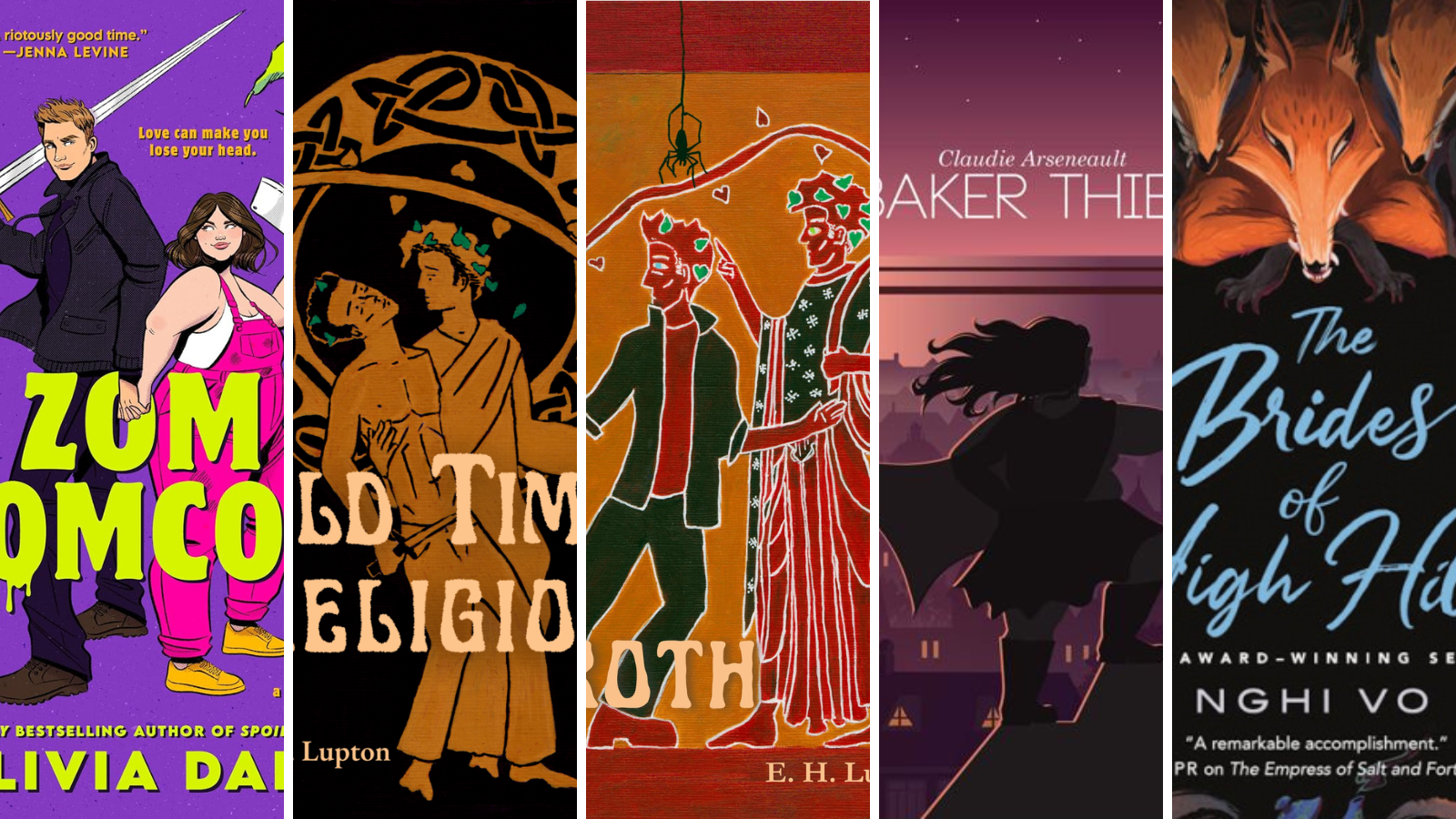Crepid
"Creep" and romance novels

CREEP, v. I was thinking about the adjective “creepy,” which comes from this very old verb meaning to move with the body close to the ground, like an insect or reptile, from which the verb developed a connotation of slowness and stealth. Then we get “creepy” by association: what it feels like if an insect is walking slowly over your skin, or anything that induces that kind of horror.
I love looking up a verb in the OED and just seeing “OE” (Old English) marked next to the first citations. English speakers have been saying “creep” for more than a thousand years! I mean, for a while we were saying “creopan” and various other Old English forms, but still. The etymology part of this entry is wonderfully rich with dialectal forms of this word: crep, crope, crop, crup, crap, croppen, cruppen, crepid. Crepid! I think we should’ve kept that as the past participle; it’s very creepy.
E. H. Lupton, whose books happened to be reviewed below, replied to my last newsletter to share an academic article about “condom” that proposes that “condom” is from con + doma/duma, meaning “with roof” or a house (like condominium), which I loved. The author is Zacharias P. Thundy. “The Etymology of Condom” was published in the 1985 summer issue of American Speech, in case you want to check it out yourself.
I found it convincing and am not sure why it’s not mentioned in the OED’s etymology section, but they probably require more evidence than my “that sounds reasonable” approach. Anyway, I think “condom” as “housing” is very funny and cute. Put a roof over that thing.
These small-r romances have zombies and witches and ghosts!
Zomromcom (pan m/het f, both cis, paranormal) by Olivia Dade. This opens with the phrase “Armed with a burrito,” which I would bet is the only time that’s ever been used as an incipit. Edie, the woman armed with the burrito, is making an ill-advised but desperate attempt to fight off a zombie to save a neighbor she thinks is a stoner bro named Chad. Edie doesn’t particularly like Chad, but she cares about everyone, and she’s sure he can’t protect himself, and she can’t leave him to die. During the fight, Chad reveals himself to be a sword-wielding vampire who is not at all in need of protection—and also, not named Chad. He saves her life, hides her in his lair, and then they embark on a quest to find out why there are zombies everywhere and how they can save themselves and their neighbors. This is zany and very sexy, and Edie, with her soap-making know-how and her cans of bizarre preserved food and her big heart and, above all, her commitment to the bit, is a delight. Purchased in print from an indie bookstore because I attended a book tour event!
Old Time Religion + Troth (gay m/bi m, both cis, historical, fantasy) by EH Lupton. These two books are the sequels to the excellent Dionysus in Wisconsin (previously reviewed), following the same two protagonists: Sam, a librarian who was briefly possessed by Dionysus, and Ulysses, a grad student and part-time magical private investigator who saved Sam from possession, became his boyfriend, and has just now completed his dissertation about Sam’s whole deal. These books are set in 1970 in my former and much missed home of Madison, Wisconsin, in a version of our world where the University of Wisconsin has a Department of Magical Studies. If you are in the mood for seasonally creepy queer romance, look no further. (Well, Old Time Religion is set in the spring, but is certainly creepy. Troth is both autumnal and creepy!) I love a series that follows the same characters through the evolution of their relationship, and it’s very fun to hang out with Sam and Ulysses as they figure out what they mean to each other in between an alarming number of episodes where people try to kill and/or do magical experiments on them. These books are so smart and so rich in their setting, and they’re just beautifully characterized romances. Indie published; library ebooks.
And in things that are neither Romance nor romance, I read Claudie Arseneault’s Baker Thief, which sort of straddles the line between fantasy and science fiction, and it stars Claude/Claire, baker by day and thief by night, who is both genderfluid and aromantic, and Adèle, the detective tasked with catching her. But Claire’s thievery is righteous, since she’s stealing “exocores,” a new energy technology she suspects might be made by horrific means. She and Adèle get caught up in the case and eventually end up working together—and working out their own form of a queerplatonic partnership along the way. I absolutely loved the setting, which is inspired by Québec and has a lot of French puns in it. Indie published; bought from itch.
I also read and loved Nghi Vo’s fantasy novella The Brides of High Hill, another entry in her Singing Hills series that follows the adventures of a cleric, Chih, who travels around recording stories with their magic, talking bird companion Almost Brilliant. They’re both wonderful characters and these novellas are always beautifully written and cleverly constructed. This one has a haunted house in it, making it a seasonally appropriate read. Library loan.
And since we’re talking about Horrors, here are some excellent horror metaphors. This isn’t the usual subject matter of this newsletter, but I’ve become a connoisseur of haterly writing about generative “AI.” I save these essays to feel like I’m not alone in my anger, and so I can hone my arguments for when this bullshit inevitably comes up in conversation. These passages have stuck with me.
But a still graver scandal of AI—like its hydra-head sibling, cryptocurrency—is the technology’s colossal wastefulness. The untold billions firehosed by investors into its development; the water-guzzling data centers draining the parched exurbs of Phoenix and Dallas; the yeti-size carbon footprint of the sector as a whole—and for what? A cankerous glut of racist memes and cardboard essays. Not only is the ratio of AI’s resource rapacity to its productive utility indefensibly and irremediably skewed, AI-made material is itself a waste product: flimsy, shoddy, disposable, a single-use plastic of the mind. — Large Language Muddle
Have you ever seen anything so perfectly succinct as “single-use plastic of the mind”?
There’s a machine in the corner wrapped in human skin that makes things out of shit and blood to look like whatever you want (as long as you don’t look too closely). You gave one to your teacher and they didn’t notice. Your boss told you to use it after they laid off half the team and it was fine. You fed one to your kids and they liked it. You want to know you can use it sometimes without me thinking less of you. You don’t need me to believe it’s useful, you just want me to be polite about it.
But I am a hater, and I will not be polite. The machine is disgusting and we should break it. — I Am An AI Hater
This is so powerfully gross, and I appreciate its simplicity. The environmental argument against AI is one that almost accepts its inevitability—like if we could do this stuff with renewable energy it would be fine—but there’s none of that here. The machine is disgusting and we should break it. Hear, hear.
That's all for this time. I'll be back in your inbox on November 9, which is somehow in two weeks.
Word Suitcase is a free newsletter about words and books. If you enjoyed this one, subscribe by email or RSS for the next one. If you know somebody who'd like reading these, please pass it along!
Websites do cost money, so there is a paid subscription option and a tip jar for one-time donations. If you feel moved to support me, I’m very grateful. But please don’t feel obligated. I love having you as a reader either way.

